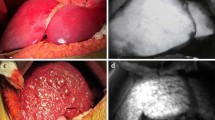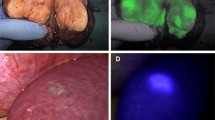Abstract
Purpose
Laparoscopic liver resection is increasingly used to treat patients with hepatic tumor. However, during laparoscopic resection, information obtained by palpation using laparoscopic forceps or from intraoperative ultrasonography is extremely limited, which may pose a risk for positive surgical margins. This study aimed to investigate the feasibility and clinical application of near-infrared (NIR) fluorescence imaging to guide laparoscopic liver resection of a liver tumor and secure the surgical margins.
Methods
A preliminary study in 25 patients was conducted. NIR imaging was used intraoperatively during laparoscopic liver resection. The liver tumors were preoperatively labeled by intravenously injecting the patients with indocyanine green dye (0.5 mg/kg), an NIR fluorescence agent. During the surgical procedure, the PINPOINT Endoscopic Fluorescence Imaging System was used to assess the surgical margin by using real-time endoscopic high-definition visible and NIR fluorescence imaging.
Results
All tumors were identified and resected laparoscopically by using the PINPOINT system, and all resections successfully secured the surgical margin. The pathological findings of all tumors indicated negative margins, defined as R0.
Conclusions
This technique showed the potential to improve the intraoperative identification and demarcation of tumors. Its use could potentially reduce the number of positive resection margins.






Similar content being viewed by others
References
Reich H, McGlynn F, DeCaprio J, Budin R (1991) Laparoscopic excision of benign liver lesions. Obstet Gynecol 78:956–958
Hibi T, Cherqui D, Geller DA et al (2016) Expanding indications and regional diversity in laparoscopic liver resection unveiled by the International Survey on Technical Aspects of Laparoscopic Liver Resection (INSTALL) study. Surg Endosc 30:2975–2983
Tanaka T, Choi HS, Fujii H et al (2006) Image-guided oncologic surgery using invisible light: completed pre-clinical development for sentinel lymph node mapping. Ann Surg Oncol 13:1671–1681
Weissleder R, Tung CH, Mahmood U, Bogdanov A (1999) In vivo imaging of tumors with protease-activated near-infrared fluorescent probes. Nat Biotechnol 17:375–378
Choi HS, Gibbs SL, Lee JH, Kim SH, Ashitate Y, Liu F, Hyun H, Park GL, Xie Y, Bae S, Henary M, Frangioni JV (2013) Targeted zwitterionic near-infrared fluorophores for improved optical imaging. Nat Biotechnol 31:148–153
Olson ES, Jiang T, Aguilera TA, Nguyen QT, Ellies LG, Scadeng M, Tsien RY (2010) Activatable cell penetrating peptides linked to nanoparticles as dual probes for in vivo fluorescence and MR imaging of proteases. Proc Natl Acad Sci U S A 107:4311–4316
Ohnishi S, Lomnes SJ, Laurence RG, Gogbashian A, Mariani G, Frangioni JV (2005) Organic alternatives to quantum dots for intraoperative near-infrared fluorescent sentinel lymph node mapping. Mol Imaging 4:172–181
Emerson DK, Limmer KK, Hall DJ, Han SH, Eckelman WC, Kane CJ, Wallace AM, Vera DR (2012) A receptor-targeted fluorescent radiopharmaceutical for multireporter sentinel lymph node imaging. Radiology 265:186–193
Brouwer OR, Klop WM, Buckle T et al (2012) Feasibility of sentinel node biopsy in head and neck melanoma using a hybrid radioactive and fluorescent tracer. Ann Surg Oncol 19:1988–1994
Hyde D, de Kleine R, MacLaurin SA et al (2009) Hybrid FMT-CT imaging of amyloid-beta plaques in a murine Alzheimer’s disease model. Neuroimage 44:1304–1311
Pham W, Zhao BQ, Lo EH, Medarova Z, Rosen B, Moore A (2005) Crossing the blood-brain barrier: a potential application of myristoylated polyarginine for in vivo neuroimaging. Neuroimage 28:287–292
Deguchi JO, Aikawa M, Tung CH et al (2006) Inflammation in atherosclerosis: visualizing matrix metalloproteinase action in macrophages in vivo. Circulation 114:55–62
Sosnovik DE, Nahrendorf M, Deliolanis N, Novikov M, Aikawa E, Josephson L, Rosenzweig A, Weissleder R, Ntziachristos V (2007) Fluorescence tomography and magnetic resonance imaging of myocardial macrophage infiltration in infarcted myocardium in vivo. Circulation 115:1384–1391
Figueiredo JL, Siegel C, Nahrendorf M, Weissleder R (2010) Intraoperative near-infrared fluorescent cholangiography (NIRFC) in mouse models of bile duct injury. World J Surg 34:336–343
Aoki T, Yasuda D, Shimizu Y, Odaira M, Niiya T, Kusano T, Mitamura K, Hayashi K, Murai N, Koizumi T, Kato H, Enami Y, Miwa M, Kusano M (2008) Image-guided liver mapping using fluorescence navigation system with indocyanine green for anatomical hepatic resection. World J Surg 32:1763–1767
Ishizawa T, Fukushima N, Shibahara J, Masuda K, Tamura S, Aoki T, Hasegawa K, Beck Y, Fukayama M, Kokudo N (2009) Real-time identification of liver cancers by using indocyanine green fluorescent imaging. Cancer 115:2491–2504
Uchiyama K, Ueno M, Ozawa S, Kiriyama S, Shigekawa Y, Yamaue H (2010) Combined use of contrast-enhanced intraoperative ultrasonography and a fluorescence navigation system for identifying hepatic metastases. World J Surg 34:2953–2959
Peloso A, Franchi E, Canepa MC, Barbieri L, Briani L, Ferrario J, Bianco C, Quaretti P, Brugnatelli S, Dionigi P, Maestri M (2013) Combined use of intraoperative ultrasound and indocyanine green fluorescence imaging to detect liver metastases from colorectal cancer. HPB (Oxford) 15:928–934
Ishizuka M, Kubota K, Kita J, Shimoda M, Kato M, Sawada T (2012) Intraoperative observation using a fluorescence imaging instrument during hepatic resection for liver metastasis from colorectal cancer. Hepatogastroenterology 59:90–92
Troyan SL, Kianzad V, Gibbs-Strauss SL, Gioux S, Matsui A, Oketokoun R, Ngo L, Khamene A, Azar F, Frangioni JV (2009) The FLARE intraoperative near-infrared fluorescence imaging system: a first-in-human clinical trial in breast cancer sentinel lymph node mapping. Ann Surg Oncol 16:2943–2952
Mieog JS, Troyan SL, Hutteman M et al (2011) Toward optimization of imaging system and lymphatic tracer for near-infrared fluorescent sentinel lymph node mapping in breast cancer. Ann Surg Oncol 18:2483–2491
Crane LM, Themelis G, Pleijhuis RG et al (2011) Intraoperative multispectral fluorescence imaging for the detection of the sentinel lymph node in cervical cancer: a novel concept. Mol Imaging Biol 13:1043–1049
Yamauchi K, Nagafuji H, Nakamura T, Sato T, Kohno N (2011) Feasibility of ICG fluorescence-guided sentinel node biopsy in animal models using the HyperEye Medical System. Ann Surg Oncol 18:2042–2047
Cahill RA, Anderson M, Wang LM, Lindsey I, Cunningham C, Mortensen NJ (2012) Near-infrared (NIR) laparoscopy for intraoperative lymphatic road-mapping and sentinel node identification during definitive surgical resection of early-stage colorectal neoplasia. Surg Endosc 26:197–204
van der Poel HG, Buckle T, Brouwer OR, Valdés Olmos RA, van Leeuwen FWB (2011) Intraoperative laparoscopic fluorescence guidance to the sentinel lymph node in prostate cancer patients: clinical proof of concept of an integrated functional imaging approach using a multimodal tracer. Eur Urol 60:826–833
Moroga T, Yamashita S, Tokuishi K, Miyawaki M, Anami K, Yamamoto S, Kawahara K (2012) Thoracoscopic segmentectomy with intraoperative evaluation of sentinel nodes for stage I non-small cell lung cancer. Ann Thorac Cardiovasc Surg 18:89–94
Jafari MD, Wexner SD, Martz JE, McLemore EC, Margolin DA, Sherwinter DA, Lee SW, Senagore AJ, Phelan MJ, Stamos MJ (2015) Perfusion assessment in laparoscopic left-sided/anterior resection (PILLAR II): a multi-institutional study. J Am Coll Surg 220:82–92
Hamady ZZ, Lodge JP, Welsh FK et al (2014) One-millimeter cancer-free margin is curative for colorectal liver metastases: a propensity score case-match approach. Ann Surg 259:543–548
Kokudo N, Miki Y, Sugai S et al (2002) Genetic and histological assessment of surgical margins in resected liver metastases from colorectal carcinoma: minimum surgical margins for successful resection. Arch Surg 137:833–840
Muratore A, Ribero D, Zimmitti G, Mellano A, Langella S, Capussotti L (2010) Resection margin and recurrence-free survival after liver resection of colorectal metastases. Ann Surg Oncol 17:1324–1329
Nuzzo G, Giuliante F, Ardito F, Vellone M, Giovannini I, Federico B, Vecchio FM (2008) Influence of surgical margin on type of recurrence after liver resection for colorectal metastases: a single-center experience. Surgery 143:384–393
Figueras J, Burdio F, Ramos E, Torras J, Llado L, Lopez-Ben S, Codina-Barreras A, Mojal S (2007) Effect of subcentimeter nonpositive resection margin on hepatic recurrence in patients undergoing hepatectomy for colorectal liver metastases. Evidences from 663 liver resections. Ann Oncol 18:1190–1195
Gotoh K, Yamada T, Ishikawa O, Takahashi H, Eguchi H, Yano M, Ohigashi H, Tomita Y, Miyamoto Y, Imaoka S (2009) A novel image-guided surgery of hepatocellular carcinoma by indocyanine green fluorescence imaging navigation. J Surg Oncol 100:75–79
Ishizawa T, Tamura S, Masuda K et al (2009) Intraoperative fluorescent cholangiography using indocyanine green: a biliary road map for safe surgery. J Am Coll Surg 208:e1–e4
Kawaguchi Y, Ishizawa T, Masuda K et al (2011) Hepatobiliary surgery guided by a novel fluorescent imaging technique for visualizing hepatic arteries, bile ducts, and liver cancers on color images. J Am Coll Surg 212:e33–e39
Kawaguchi Y, Ishizawa T, Harada Y et al (2013) IntraoperativeIdentification of bile duct perforation following ERCP using indocyanine green-fluorescence imaging. Dig Dis Sci 59:1063–1065
Kubota K, Kita J, Shimoda M, Rokkaku K, Kato M, Iso Y, Sawada T (2006) Intraoperative assessment of reconstructed vessels in living-donor liver transplantation, using a novel fluorescence imaging technique. J Hepato-Biliary-Pancreat Surg 13:100–104
Kawaguchi Y, Ishizawa T, Miyata Y, Yamashita S, Masuda K, Satou S, Tamura S, Kaneko J, Sakamoto Y, Aoki T, Hasegawa K, Sugawara Y, Kokudo N (2013) Portal uptake function in veno-occlusive regions evaluated by real-time fluorescent imaging using indocyanine green. J Hepatol 58:247–253
Kawaguchi Y, Sugawara Y, Ishizawa T, Satou S, Kaneko J, Tamura S, Aoki T, Sakamoto Y, Hasegawa K, Kokudo N (2013) Identification of veno-occlusive regions in a right liver graft after reconstruction of vein segments 5 and 8: application of indocyanine green fluorescence imaging. Liver Transpl 19:778–779
Shimada S, Ohtsubo S, Ogasawara K, Kusano M (2015) Macro- and microscopic findings of ICG fluorescence in liver tumors. World J Surg Oncol 13:198. https://doi.org/10.1186/s12957-015-0615-5
Vahrmeijer AL, Hutteman M, van der Vorst JR, van de Velde CJH, Frangioni JV (2013) Image-guided cancer surgery using near-infrared fluorescence. Nat Rev Clin Oncol 10:507–518
Kudo H, Ishizawa T, Tani K, Harada N, Ichida A, Shimizu A, Kaneko J, Aoki T, Sakamoto Y, Sugawara Y, Hasegawa K, Kokudo N (2014) Visualization of subcapsular hepatic malignancy by indocyanine-green fluorescence imaging during laparoscopic hepatectomy. Surg Endosc 28:2504–2508
Takahashi H, Zaidi N, Berber E (2016) An initial report on the intraoperative use of indocyanine green fluorescence imaging in the surgical management of liver tumors. J Surg Oncol 114:625–629
Ciria R, Cherqui D, Geller DA, Briceno J, Wakabayashi G (2016) Comparative short-term benefits of laparoscopic liver resection: 9000 cases and climbing. Ann Surg 263:761–777
Acknowledgements
The authors thank Dr. Kosuke Yamada, Dr. Koji Nogaki, and Dr. Yoshihiko Tashiro (Showa University) for their assistance with acquisition of data; Dr. Yusuke Wada, Dr. Tomoki Hakozaki, Dr. Kodai Tomioka, and Dr. Hideki Shibata (Showa University); and Dr. Kris Siriratsivawong (Showa University) for the revision of the manuscript.
Author information
Authors and Affiliations
Contributions
T. A. and M. M. were responsible for the study conception and design; T. K., K. M., A. F., and T. K. for the acquisition of data; Y. E., S. G., M. W., and K. O. for the analysis and interpretation of data; T. A. for the drafting of the manuscript; and M. M. for the critical revision of the manuscript.
Corresponding author
Ethics declarations
Conflict of interest
The authors declare that they have no conflicts of interest.
Ethical approval
All procedures performed in studies involving human participants were in accordance with the ethical standards of the institutional research committee and with the 1964 Helsinki declaration and its later amendments.
Informed consent
Informed consent was obtained from all individual participants included in the study.
Rights and permissions
About this article
Cite this article
Aoki, T., Murakami, M., Koizumi, T. et al. Determination of the surgical margin in laparoscopic liver resections using infrared indocyanine green fluorescence. Langenbecks Arch Surg 403, 671–680 (2018). https://doi.org/10.1007/s00423-018-1685-y
Received:
Accepted:
Published:
Issue Date:
DOI: https://doi.org/10.1007/s00423-018-1685-y




